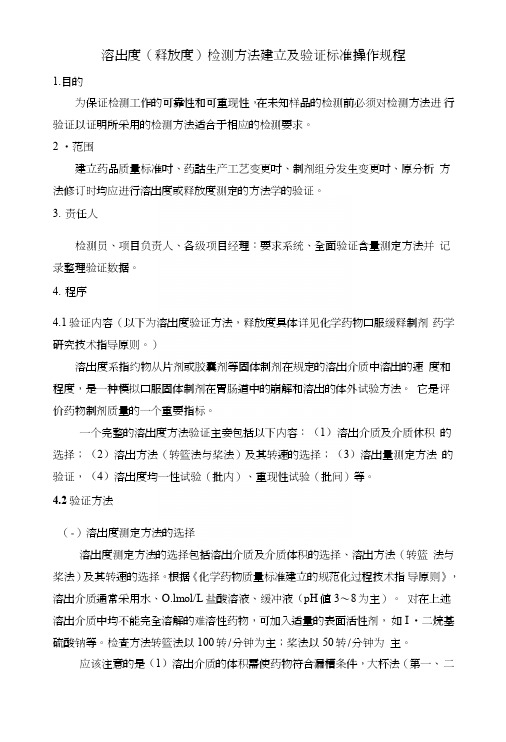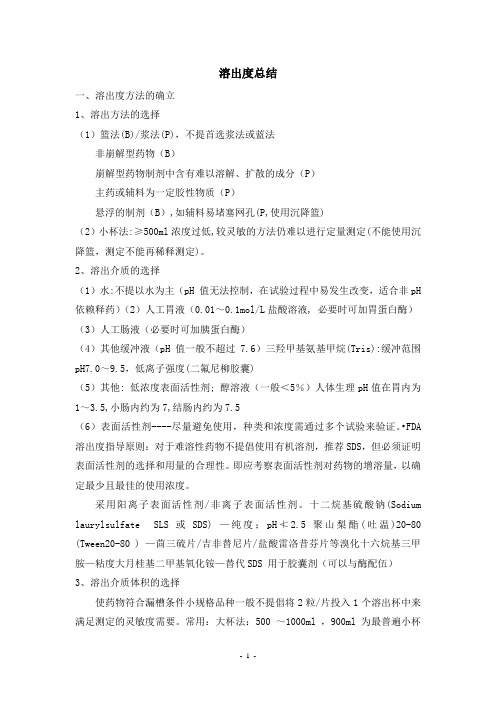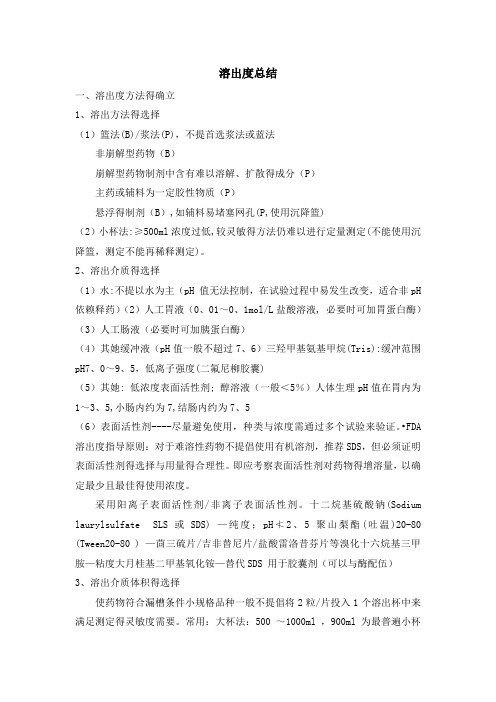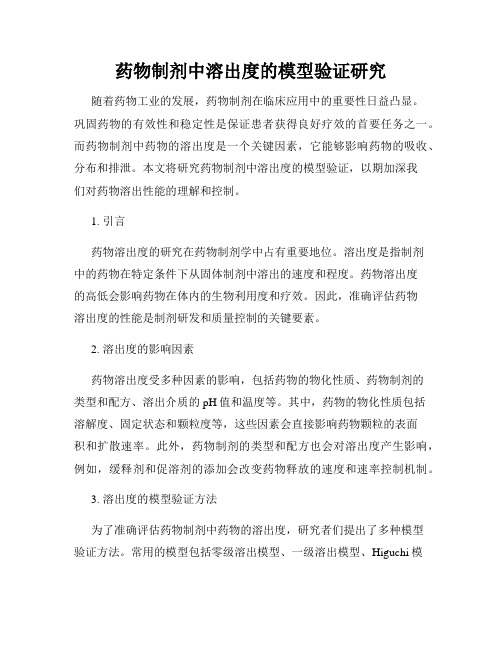溶出度方法学验证-7
溶出度(释放度)检测方法建立及验证标准操作规程.doc

溶出度(释放度)检测方法建立及验证标准操作规程1.目的为保证检测工作的可靠性和可重现性,在未知样品的检测前必须对检测方法进行验证以证明所采用的检测方法适合于相应的检测要求。
2 •范围建立药品质量标准吋、药詁生产工艺变更吋、制剂组分发生变更吋、原分析方法修订时均应进行溶出度或释放度测定的方法学的验证。
3.责任人检测员、项目负责人、各级项目经理:要求系统、全面验证含量测定方法并记录整理验证数据。
4.程序4.1验证内容(以下为溶出度验证方法,释放度具体详见化学药物口服缓释制剂药学研究技术指导原则。
)溶出度系指约物从片剂或胶囊剂等固体制剂在规定的溶出介质中溶出的速度和程度,是一种模拟口服固体制剂在胃肠道中的崩解和溶出的体外试验方法。
它是评价药物制剂质量的一个重要指标。
一个完整的溶出度方法验证主妾包括以下内容:(1)溶出介质及介质休积的选择;(2)溶出方法(转篮法与桨法)及其转速的选择;(3)溶出量测定方法的验证,(4)溶出度均一性试验(批内)、重现性试验(批间)等。
4.2验证方法(-)溶出度测定方法的选择溶出度测定方法的选择包括溶出介质及介质体积的选择、溶出方法(转篮法与桨法)及其转速的选择。
根据《化学药物质量标准建立的规范化过程技术指导原则》,溶出介质通常采用水、O.lmol/L盐酸溶液、缓冲液(pH值3〜8为主)。
对在上述溶出介质中均不能完全溶解的难溶性药物,可加入适量的表面活性剂,如I •二烷基硫酸钠等。
检查方法转篮法以100转/分钟为主;桨法以50转/分钟为主。
应该注意的是(1)溶出介质的体积需使药物符合漏槽条件,大杯法(第一、二法)常用体积为500〜1000ml,小杯法(第三法)常用体积为100〜250ml。
部分品种为满足在溶出量测定时药物浓度的需要,可采用低于上述限度范围的溶剂。
(2)介质、方法、转速的选择一般根据溶出曲线测定结果确定。
部分资料简单-地通过比较主药在各溶剂屮的溶解度来选择溶出介质,我们认为相同的溶剂可能会导致对不同制剂溶出行为的差异,且工艺的选择、辅料的加入能改变主约在不同溶剂屮的溶解行为,故仅考虑溶解度是不适合的;部分资料根据单点测定结果进行方法和转速选择,如盐酸左旋多巴甲酯片屮报资料中采用篮法lOOrpm和桨法75rpm比较,结果45min溶出均大于95%,故选择桨法75rpm测定溶出度, 单点测定不能很好区分不同处方和生产工艺的溶出情况,也影响溶出拐点的确定,故不合适;考虑今后大生产工艺,中报单位确定溶出度检查方法中常采用高转速或延长取样时间,取样时间与溶出曲线的拐点位置相距较远,导致溶出度测定区分能力不明显,溶出度取样时间常选择溶出曲线的拐点处后推10〜20分钟, 如果时间较长或太短,可通过适当提高或减低转速等手段重新测定溶出曲线。
溶出度检测方法建立及验证标准操作规程

溶出度检测方法建立及验证标准操作规程溶出度(释放度)检测是药物质量控制中的重要测试之一,用于评估药物的溶出性能。
溶出度测试可以确定药物在固体药物制剂中的药物溶出速率,从而判断药物的口服吸收和生物利用度。
本文将介绍溶出度检测方法的建立及验证标准操作规程。
1.仪器和试剂准备(1)溶出度仪器:常用的溶出度仪包括旋转篮法、磁力驱动法和流动池法等。
根据需求选择适合的仪器。
(2)溶出介质:根据药物特性选择适当的溶出介质,如水、缓冲液、模拟胃肠液等。
(3)试剂:如酸或硷,用于调整溶出介质的pH值。
2.样品制备(1)固体制剂:称取一定重量的固体制剂,放入溶出度仪的样品容器中,加入适量的溶出介质,封闭样品容器。
(2)液体制剂:取一定量的液体制剂,放入溶出度仪的样品容器中,封闭样品容器。
3.溶出度测试条件设定(1)旋转篮法和磁力驱动法:设定速度、旋转篮或磁力驱动子的数量等。
(2)流动池法:设定流速、温度和流动池的体积等。
4.溶出度测试操作(1)样品容器准备:根据所选的溶出度仪器选择适当的样品容器。
(2)样品装载:将样品容器放入溶出度仪器中,根据仪器要求加入预定体积的溶出介质。
(3)测试条件设定:根据所选的溶出度仪器设定相应的测试条件,如速度、温度等。
(4)样品测试:启动溶出度仪器,按照设定条件进行样品测试。
(5)结果记录:根据溶出度仪器的要求,记录样品测试结果。
5.数据处理和结果分析(1)计算溶出度:根据样品测试结果,计算出药物的溶出度或释放度。
(2)结果分析:对溶出度结果进行统计学分析,如平均值、标准偏差等。
二、方法建立1.选择合适的仪器和试剂,根据药物特性和要求选择合适的溶出度仪器和溶出介质。
2.设定溶出度测试条件,包括旋转篮法、磁力驱动法或流动池法的相关参数。
3.开展溶出度测试,根据所选的溶出度仪器和条件进行样品测试。
4.收集测试数据,根据测试结果计算药物的溶出度或释放度。
5.对测试结果进行分析和评估,根据统计学方法验证方法的准确性和可靠性。
溶出度

溶出度总结一、溶出度方法的确立1、溶出方法的选择(1)篮法(B)/浆法(P),不提首选浆法或蓝法非崩解型药物(B)崩解型药物制剂中含有难以溶解、扩散的成分(P)主药或辅料为一定胶性物质(P)悬浮的制剂(B),如辅料易堵塞网孔(P,使用沉降篮)(2)小杯法:≥500ml浓度过低,较灵敏的方法仍难以进行定量测定(不能使用沉降篮,测定不能再稀释测定)。
2、溶出介质的选择(1)水:不提以水为主(pH 值无法控制,在试验过程中易发生改变,适合非pH 依赖释药)(2)人工胃液(0.01~0.1mol/L盐酸溶液, 必要时可加胃蛋白酶)(3)人工肠液(必要时可加胰蛋白酶)(4)其他缓冲液(pH值一般不超过7.6)三羟甲基氨基甲烷(Tris):缓冲范围pH7.0~9.5,低离子强度(二氟尼柳胶囊)(5)其他: 低浓度表面活性剂; 醇溶液(一般<5%)人体生理pH值在胃内为1~3.5,小肠内约为7,结肠内约为7.5(6)表面活性剂----尽量避免使用,种类和浓度需通过多个试验来验证。
•FDA 溶出度指导原则:对于难溶性药物不提倡使用有机溶剂,推荐SDS,但必须证明表面活性剂的选择和用量的合理性。
即应考察表面活性剂对药物的增溶量,以确定最少且最佳的使用浓度。
采用阳离子表面活性剂/非离子表面活性剂。
十二烷基硫酸钠(Sodium laurylsulfate SLS或SDS) —纯度;pH≦2.5聚山梨酯(吐温)20-80 (Tween20-80 ) —茴三硫片/吉非替尼片/盐酸雷洛昔芬片等溴化十六烷基三甲胺—粘度大月桂基二甲基氧化铵—替代SDS 用于胶囊剂(可以与酶配伍)3、溶出介质体积的选择使药物符合漏槽条件小规格品种一般不提倡将2粒/片投入1个溶出杯中来满足测定的灵敏度需要。
常用:大杯法:500 ~1000ml ,900ml为最普遍小杯法:100~250ml。
漏槽条件:即所用介质的体积应达到被测物质在37℃时在此介质中达到饱和溶液浓度的体积的3~10倍。
溶出度方法学验证

溶出度方法学验证
溶出度方法学验证是一种常用的药物溶出度测试方法,用于评估固体药物制剂在特定条件下的药物释放速度。
通过该方法可以比较不同制剂的溶出行为,敏感性以及药物溶出动力学。
溶出度方法学验证通常包括以下几个步骤:
1. 准备溶出介质:选择适当的介质,如模拟胃肠液、模拟体液等,并调整其pH 和温度。
2. 准备固体药物制剂:将药物制剂加入溶出器中,例如溶出度仪器的溶出器。
3. 设定实验条件:设定溶出温度、转速、溶出介质的体积等。
4. 开始实验:启动溶出度仪器,开始记录药物溶出过程。
根据所需的时间点,取样分析溶出介质中的药物浓度。
5. 分析数据:根据取样的药物浓度数据,计算溶出度曲线、累积释放度和速率等药物溶出参数。
6. 数据解释和结果分析:根据溶出度测试的结果,评估药物制剂的溶出性能,并与其他制剂进行比较。
在溶出度方法学验证过程中,一般要注意选择合适的试验条件,如适当的转速、温度、体积等,以确保测试结果的可重复性和可比性。
同时,还要注意样品的制备、溶解度测定方法的准确性等,以提高测试的精确性。
总之,溶出度方法学验证是一种有效评估固体药物制剂溶出性能的方法,对于药物研发、质量控制和生物等效性评价具有重要意义。
溶出度仪验证方案

溶出度仪验证方案引言溶出度仪在药学和化学领域中被广泛用于评估药物的释放特性。
然而,为了确保溶出度仪的准确性和可靠性,在使用之前需要进行验证。
本文将介绍溶出度仪验证的方案,包括验证目的、操作步骤和验证结果的分析。
验证目的溶出度仪验证的目的是确保该仪器在测量药物溶出度时具有准确性和可靠性。
验证的过程应覆盖仪器的所有关键参数,以便保证所得到的数据可靠可信。
验证方法以下是进行溶出度仪验证的具体操作步骤:步骤一:仪器设备验证1.根据溶出度仪的说明书,检查所有电气设备和连接线路,确保其正常工作。
2.检查温度控制器是否准确,使用温度计校准温度。
3.检查搅拌器的速度控制是否准确,使用万用表测量转速。
4.验证自动取样器的准确性,将一定量的试剂溶解在溶液中进行测试,并与手动操作进行对比。
步骤二:试剂验证1.使用精密天平称量一定量的试剂,记录其质量。
2.将试剂添加到溶剂中,并搅拌一定时间。
3.使用不同的试剂浓度进行多次实验,记录每次试验的实际溶出度。
步骤三:时间验证1.设置合适的时间间隔进行溶出度测量,例如每隔10分钟或每隔30分钟。
2.对同一批溶剂进行多次实验,记录每次实验的溶出度。
3.验证溶出度仪是否在相同的时间间隔内给出相似的结果。
步骤四:温度验证1.设置不同的温度条件进行溶出度测量,例如25℃、37℃和45℃。
2.对相同的溶剂进行多次实验,记录每次实验的溶出度。
3.验证溶出度仪在不同温度条件下给出相似的结果。
验证结果分析对于每个验证步骤,应记录测量结果并进行分析。
以下是对验证结果的常见分析方法:1.试剂验证结果:计算每次实验的平均溶出度并确定其标准偏差。
如果各次实验结果相差较大,则需要重新检查试剂和溶剂的准确性。
2.时间验证结果:比较同一批溶剂在不同时间间隔内测量的溶出度结果。
如果相邻时间间隔内的结果差异较大,则需要重新检查时间控制是否准确。
3.温度验证结果:比较相同溶剂在不同温度条件下测量的溶出度结果。
如果不同温度条件下的结果差异较大,则需要重新检查温度控制是否准确。
溶出度

溶出度总结一、溶出度方法得确立1、溶出方法得选择(1)篮法(B)/浆法(P),不提首选浆法或蓝法非崩解型药物(B)崩解型药物制剂中含有难以溶解、扩散得成分(P)主药或辅料为一定胶性物质(P)悬浮得制剂(B),如辅料易堵塞网孔(P,使用沉降篮)(2)小杯法:≥500ml浓度过低,较灵敏得方法仍难以进行定量测定(不能使用沉降篮,测定不能再稀释测定)。
2、溶出介质得选择(1)水:不提以水为主(pH 值无法控制,在试验过程中易发生改变,适合非pH 依赖释药)(2)人工胃液(0、01~0、1mol/L盐酸溶液, 必要时可加胃蛋白酶)(3)人工肠液(必要时可加胰蛋白酶)(4)其她缓冲液(pH值一般不超过7、6)三羟甲基氨基甲烷(Tris):缓冲范围pH7、0~9、5,低离子强度(二氟尼柳胶囊)(5)其她: 低浓度表面活性剂; 醇溶液(一般<5%)人体生理pH值在胃内为1~3、5,小肠内约为7,结肠内约为7、5(6)表面活性剂----尽量避免使用,种类与浓度需通过多个试验来验证。
•FDA 溶出度指导原则:对于难溶性药物不提倡使用有机溶剂,推荐SDS,但必须证明表面活性剂得选择与用量得合理性。
即应考察表面活性剂对药物得增溶量,以确定最少且最佳得使用浓度。
采用阳离子表面活性剂/非离子表面活性剂。
十二烷基硫酸钠(Sodium laurylsulfate SLS或SDS) —纯度;pH≮2、5聚山梨酯(吐温)20-80 (Tween20-80 ) —茴三硫片/吉非替尼片/盐酸雷洛昔芬片等溴化十六烷基三甲胺—粘度大月桂基二甲基氧化铵—替代SDS 用于胶囊剂(可以与酶配伍)3、溶出介质体积得选择使药物符合漏槽条件小规格品种一般不提倡将2粒/片投入1个溶出杯中来满足测定得灵敏度需要。
常用:大杯法:500 ~1000ml ,900ml为最普遍小杯法:100~250ml。
漏槽条件:即所用介质得体积应达到被测物质在37℃时在此介质中达到饱与溶液浓度得体积得3~10倍。
片溶出度试验方法学验证

×××片溶出度试验方法学验证1、溶出度依据国家食品药品监督管理局国家药品标准新药转正标准第二十八册×××片溶出度试验方法、《中国药典》2010年版二部溶出度测定法(附录Ⅹ C)的有关要求,并参照文献进行本品的溶出度研究。
(1)溶出介质及介质体积的选择溶出介质应根据制剂的特性选用水、0.01~0.1mol/L盐酸溶液或适宜的缓冲液(pH值一般不超过7.6),应临用新制并经脱气处理。
对于极难溶出的品种,可加适量表面活性剂,如十二烷基硫酸钠(0.5%以下),如确需使用有机溶剂,可加适量,如异丙醇、乙醇等(通常浓度在5%以下),但应有依据,并尽量选用低浓度。
溶出介质的体积一般应符合漏槽条件。
×××在水中微溶,且本品为小规格品种(规格为2.5mg),根据以上溶出介质选择的原则及已有国家标准的方法,选择已有国家标准中采用的溶出介质及体积:0.1mol/L盐酸溶液〔盐酸溶液(9→1000)〕200ml。
(2)溶出方法及其转速的选择方法的选择一般可参照下列原则:①对于非崩解型药物,宜采用转篮法。
②对于崩解型药物,在进行转篮法的整个试验过程中,确保转篮网孔的通透性尤为重要,对于处方中主药或辅料(如胶性物质)影响转篮通透性的固体制剂,一般应采用桨法。
③制剂中含有难以溶解、扩散的成分,一般应采用桨法。
④对飘浮于液面的制剂,一般应选用转篮法。
如辅料堵塞网孔则选用桨法,将供试品放入沉降篮中,并在正文中加以规定。
采用小杯法时不能使用沉降篮。
⑤小杯法主要用于在转篮法和桨法条件下,溶出液的浓度过稀,即使采用较灵敏的方法仍难以进行定量测定的品种。
转速选择的原则:在质量研究的基础上,尽量选择低转速,转篮法推荐100转/分,最低不得低于50转/分;桨法推荐50转/分,最高不超过75转/分;小杯法推荐35转/分,最高不超过50转/分。
×××在水中微溶,且本品为小规格品种(规格为2.5mg),根据以上溶出方法选择的原则、转速选择的原则及已有国家标准的方法,选择已有国家标准中采用的溶出方法及转速:小杯法,50转每分钟。
药物制剂中溶出度的模型验证研究

药物制剂中溶出度的模型验证研究随着药物工业的发展,药物制剂在临床应用中的重要性日益凸显。
巩固药物的有效性和稳定性是保证患者获得良好疗效的首要任务之一。
而药物制剂中药物的溶出度是一个关键因素,它能够影响药物的吸收、分布和排泄。
本文将研究药物制剂中溶出度的模型验证,以期加深我们对药物溶出性能的理解和控制。
1. 引言药物溶出度的研究在药物制剂学中占有重要地位。
溶出度是指制剂中的药物在特定条件下从固体制剂中溶出的速度和程度。
药物溶出度的高低会影响药物在体内的生物利用度和疗效。
因此,准确评估药物溶出度的性能是制剂研发和质量控制的关键要素。
2. 溶出度的影响因素药物溶出度受多种因素的影响,包括药物的物化性质、药物制剂的类型和配方、溶出介质的pH值和温度等。
其中,药物的物化性质包括溶解度、固定状态和颗粒度等,这些因素会直接影响药物颗粒的表面积和扩散速率。
此外,药物制剂的类型和配方也会对溶出度产生影响,例如,缓释剂和促溶剂的添加会改变药物释放的速度和速率控制机制。
3. 溶出度的模型验证方法为了准确评估药物制剂中药物的溶出度,研究者们提出了多种模型验证方法。
常用的模型包括零级溶出模型、一级溶出模型、Higuchi模型和Korsmeyer-Peppas模型等。
这些模型基于不同的假设和方程式,通过拟合实验数据来预测溶出度的变化规律。
4. 零级溶出模型零级溶出模型假设溶出速率与时间无关。
在这种模型中,药物的溶出速率保持恒定。
这个模型常用于缓释制剂或控释制剂的溶出度评估。
通过实验数据的拟合,可以得到药物在制剂中的初始释放速率。
5. 一级溶出模型一级溶出模型假设溶出速率与溶出物的浓度成正比。
在这种模型中,药物的溶出速率随时间逐渐减慢,最终趋近于0。
这个模型常用于评估普通制剂中的药物溶出度,并可以提供释放速率常数K。
6. Higuchi模型Higuchi模型是根据药物在制剂中扩散的规律提出的。
这个模型假设药物在制剂中的溶出速率与扩散距离的平方根成正比。
- 1、下载文档前请自行甄别文档内容的完整性,平台不提供额外的编辑、内容补充、找答案等附加服务。
- 2、"仅部分预览"的文档,不可在线预览部分如存在完整性等问题,可反馈申请退款(可完整预览的文档不适用该条件!)。
- 3、如文档侵犯您的权益,请联系客服反馈,我们会尽快为您处理(人工客服工作时间:9:00-18:30)。
– Quats will ion pair with carboxylic acids at 2 pH’s units above pKa
13
Specific problems with SLS
• Use in combination only with Sodium Phosphate for 6.8 pH not Potassium Phosphate—precipitates at room temp
– Anionic
– Non-ionic
Evaluate different surfactants [quantitative]
4
Official Statements
FDA
• A dissolution medium containing surfactant can better simulate the environment of the gastrointestinal tract than a medium containing organic solvents or other nonphysiological substances, making the dissolution test conditions more useful in evaluating drug quality.
• Polysorbates (Tween™) • Sodium dodecyl sulfate (sodium lauryl sulfate) • Lauryl dimethyl amine oxide • Cetyltrimethylammonium bromide (CTAB) • Polyethoxylated alcohols • Polyoxyethylene sorbitan • Octoxynol (Triton X100™) • N, N–dimethyldodecylamine– N–oxide • Hexadecyltrimethylammonium bromide (HTAB)
• Stability problems below pH 2.5 • Denaturing of enzymes used in two tier dissolution testing with crosslinking • Over effective due to excessive surface tension reduction
– However, respective results are not an acceptable way to establish an in vitro/in vivo correlation.
• The pH conditions to be employed are at least pH 1.2, 4.5, and 6.8. Additional investigations may be required at pH values in which the drug substance has minimum solubility. • The use of any surfactant is strictly discouraged.
12
Some points to remember
• The use of surfactants is not straightforward
– The API does not dissolve as such-it forms micelles
• Some surfactants dramatically lower surface tension which may not mimic the physiological situation [SLS]
BCS guidance, solubility is high if more than 160/250=0.64 mg/mLis soluble across pH range 1-7.5 Solubility based on 250ml volume
Having no ionizable groups, fenofibrate solubility is not 7 influenced by changes of the pH of the dissolution medium
14
The new EMA guidance
• Investigations related to the drug product should ensure immediate release properties and prove similarity between the investigative products, i.e. test and reference have a similar in vitro dissolution considering physiologically relevant experimental pH conditions.
Medium Sol mcg/ml DI Water 0.8 0.72% SLS 195 1.44% SLS 446 2.16% SLS 728 2% Tween 80 134
9
Valdecoxib dissolution
2.0% SLS 1.5% SLS 1.0% SLS 0.5%SLS 0.2% SLS
Worrying because the rate of dissolution does not really change, only the amount dissolved
10
Ketoprofen dissolution profile
11
Surfactants used in dissolution for PWSDS
– Increased wetting may give much higher dissolution than would be achieved in the GIT
• Be aware of chemical effects with ionic surfactants
– Sulphonic acid salts will ion-pair with amines at most pH’s
5
Poorly soluble drugs using surfactants [USP]
Estradiol/norgestimate (1mg/0.09mg) Ethinyl Estradiol/Norgestrel Amiodarone HCl (Test 2) Dicumerol Levonorgestrel Glyburide [non-micronized] Metolazone Tolcapone Tamsulosin HCl 0.3% SLS in water Water with 5 ppm of Tween 80 Acetate Buffer, pH 4.0, with 1% Tween 80 Basket 100 rpm, 1000 mL 0.1 TRIS buffer pH 9.0, 0.1 N HCl with 0.1% SLS Paddle 75rpm. 900ml., 0.5% CTAB in pH 9.0 borate buffer Paddle 75rpm, 900 mL 2.0% SLS/Water, Borate Buffer, pH 6.8 with 1% SLS 0-2 hours: 0.003% polysorbate 80, pH 1.2 2-8 hours: phosphate buffer, pH 7.2
• These may present a significant challenge
• For multiple actives a single dissolution test should be aimed for.
Development of dissolution ethods
Compound specific
1
Types of compounds
SPARINGLY SOLUBLE
pH INDEPENDENT
pH DEPENDENT
COMBINATION PRODUCTS
2
Poorly water soluble compounds
• All such methods have moved to aqueous media using surfactants*
*But now alcoholic medium is used to prove absence of dose dumping3
Development steps for PWSDs
15
Combination products
16
Combination products
• There are two meanings of combination products
– One or more active ingredient – A combination drug and device [considered under special dosage forms]
Dissolution 54mg Fenofibrate tablet 75 rpm
/
AAPS pharm sci tech 2006;7(2) Art33
8
Poorly water soluble drugs: Surfactants
6
Fenofibrate
• No ionizable group (neutral)
– Solubility----Practically insoluble in water
• Highest strength=160mg, • Water Solubility is 0.008mg/mL therefore BCS low solubility drug.
